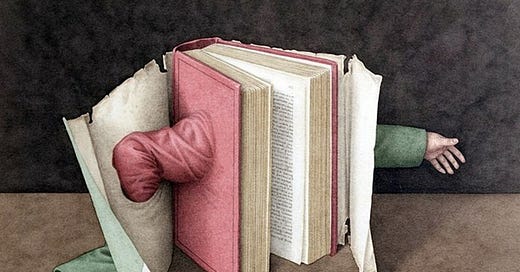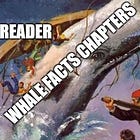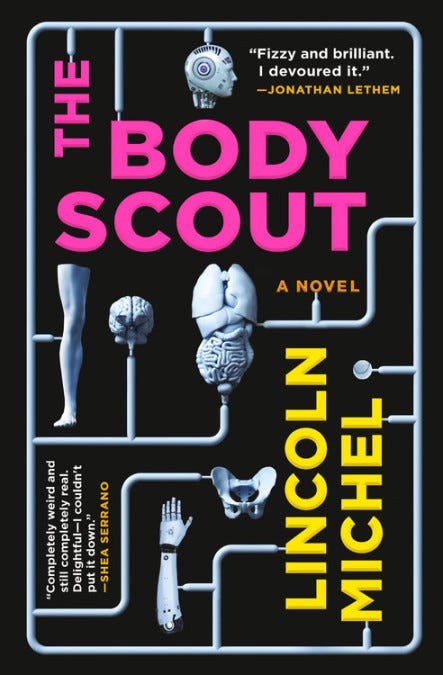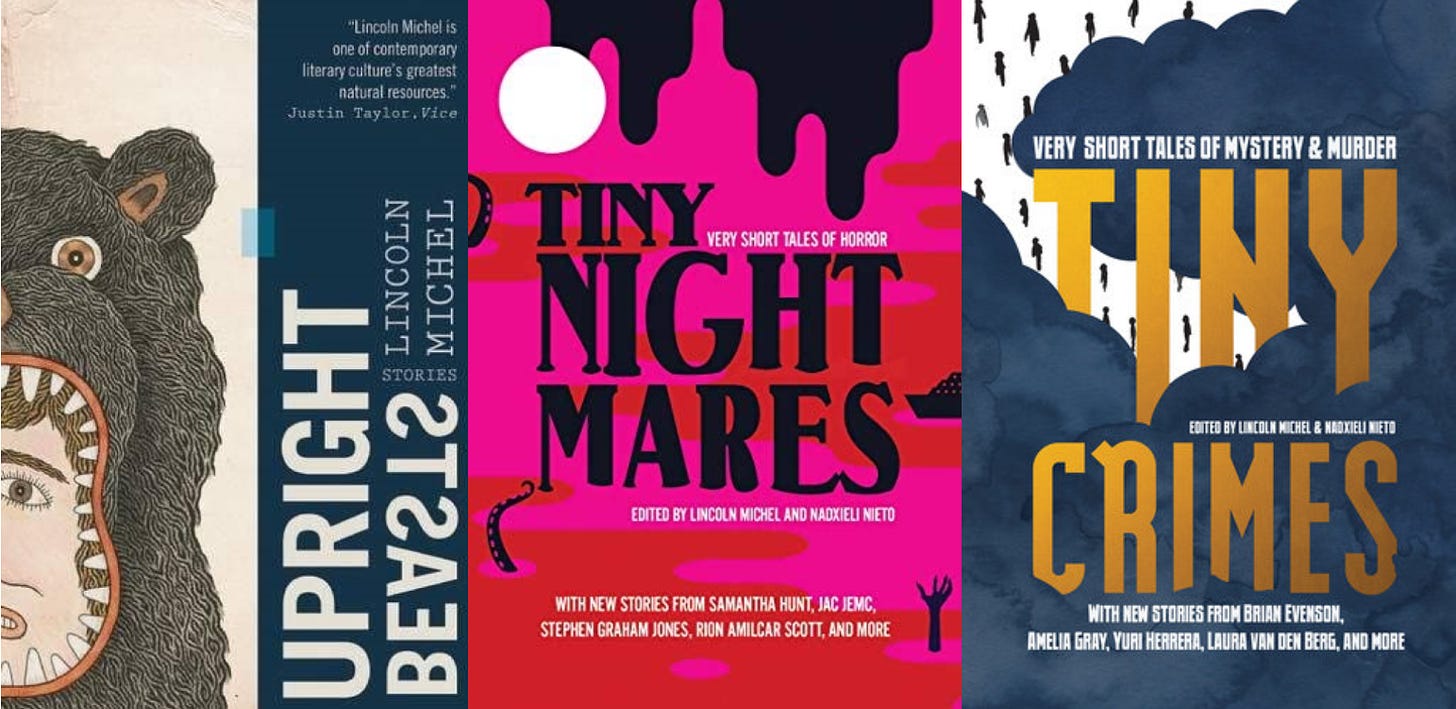Hi everyone, I’m back from a brief hiatus in which I read some good, weird books. One of them was a galley of the novel Gretel and the Great War by Adam Ehrlich Sachs—coming out from FSG this summer—that is set in 1919 Austria and composed of letters from a man in a sanatorium to a mute woman he claims is his daughter. I really enjoyed the novel, which feels a bit like Brothers Grimm meets Thomas Bernhard, and especially admired its tricky form. The novel consists of 26 bedtime stories the man writes that work individually as stories while also painting a larger portrait of pre-war Vienna and slowly telling the story of the man and the daughter.
As I wrote last year, I’ve always loved novels that play around with structure and repurpose other textual forms. (Indeed, I taught an entire course this semester on the topic.) They’re part of a grand tradition. The novel has, more or less since it’s inception, been a form that absorbs other forms. It’s protean and peckish. It wants to gobble up all other types of text and grow larger from them. Letters, emails, poems, text messages, corporate documents, you name ‘em and novels have included ‘em. The postmodernists get lots of credit (or blame) for deconstructing the ossified form of the novel… but really the novel has always been admirably shape shifting. Moby-Dick includes chapters as plays and lists of whale facts, Tristram Shandy has illustrations and digressions, and many famous were written in the form of letters or diary entries (Frankenstein, Dracula, The Sorrows of Young Werther, etc.)
Most novels, in my view, can benefit from some playfulness on the page. Shake things up, try something new, what’s to lose? But since I’ve covered that topic before, I thought I’d write about something more specific: novels that are entirely in unusual forms. Not just some passages, but the entire thing. Novels that have to smuggle in their characters, plots, and narratives inside shapes where we don’t expect them. These books exhibit one of the hardest qualities to pull off in literature: commitment to the bit.
Novel as Scholarly Endnotes to a Poem: Pale Fire by Vladimir Nabokov
This is the classic unusual structure novel, and one of my favorite novels of all time. It exemplifies all the humor, playfulness, scholarliness, and poetic language that makes Nabokov Nabokov. Pale Fire opens with a long (and mediocre) poem and the rest of the novel is composed of endnotes to said poem with professor Charles Kinbote weaving in the tragicomic tale of his relationship with the poet and his own fantastical life story.
Novel as Series of Spaceship Employee Interview Transcripts: The Employees by Olga Ravn
This recent Danish novel—translated into English last year by Martin Atkin—is a poetic and surreal science fiction novel that’s composed of transcripts of workers on a spaceship. The ship has been collecting samples from a newly discovered planet and the corporation is investigating the effects on the human and non-human employees. Its mysterious and magical, and short enough to read during lunch breaks at your own dystopian capitalist workplace.
Novel as Workplace Slack Messages: Several People Are Typing by Calvin Kasulke
Another recent speculative workplace novel, this one is written entirely in the form of Slack messages from a character who gets trapped inside the app. It’s a lot of fun and a great example of how modern technology can be productively integrated into fiction. I interviewed Kasulke here about the novel when it came out in 2021.
Novel as Phone Sex Transcript: Vox by Nicholson Baker
Baker has a lot of books that might fit this post. I wrote about his debut novel The Mezzanine earlier this year, which is fantastic footnote-filled novel about the beauty and mundanity of modern life. That might also describe his third novel, Vox, although instead of lots of footnotes the novel is written as a transcript of a call to a phone sex hotline. (I think I’m required to note here that this novel was infamously gifted by Monica Lewinsky to Bill Clinton.)
Novel as Standardized Test: Multiple Choice by Alejandro Zambra
Zambra is one of my favorite living fiction writers and while he often writes in more conventional narrative forms, Multiple Choice (translated by Megan McDowell) is written in the form of the Chilean Academic Aptitude Test—basically the Chilean SAT—meaning there is a chapter of fill-in-the-blank questions and a chapter of reader response questions, among others. Zambra has great fidelity to the form yet still manages to turn standardized test questions into poetry. There isn’t much of an overarching story here but there are recurrences and themes that cohere the highly inventive book.
Novel(la) as Summaries of TV Episodes: “Especially Heinous” by Carmen Maria Machado
This novella appears in Machado’s excellent and now classic short story collection Her Body and Other Parties. Its wild and weird form is explained in the subtitle: “272 Views of Law & Order SVU.” Machado writes 272 capsule summaries of invented SVU episodes that seem to air in some alternative, Lynchian dimension where Stabler and Benson face off with ghosts, doppelgangers, and other eerie events.
Novel as Biographies of Fascist Poets: Nazi Literature in the Americas by Roberto Bolaño
There is a probably a whole subcategory of novels in strange forms that might be called the list novel. My go-to example is Italo Calvino’s Invisible Cities, a novel composed of short descriptions of invented cities. But this time I’ll recommend Bolaño’s list novel Nazi Literature in the Americas (translated by Chris Andrews). Here, Bolaño writes short biographies of a variety of invented fascist poets mostly from South America with a few from North America. One of the characters was expanded into Distant Star, one of Bolaño’s best books.
Novel as Screenplay: Interior Chinatown by Charles Yu
Charles Yu is a writer who loves to play with both genre and form, which is evident in his excellent story collections as well as his National Book Award-winning debut novel Interior Chinatown. Formally, the novel is written as a screenplay and narratively the characters exist in a kind of perpetual crime drama. I wrote about the novel’s “serious playfulness” for Alta magazine.
Novel as Nightmare: Fever Dream by Samanta Schweblin
This one is tricky to describe without spoiling but suffice to say the translated (by Megan McDowell) title Fever Dream is an apt description of the vibe. (The original Spanish title is Distancia de rescate or "rescue distance,” which refers to a key idea in the book.) Formally, Fever Dream is a conversation between a young boy who may not be a young boy and a woman who may or may not be awake.
Novel as Multiple Encyclopedias: The Dictionary of the Khazars by Milorad Pavić
One of the most unique and unusual novels ever written, Dictionary of the Khazars: A Lexicon Novel in 100,000 Words (translated by Christina Pribicevic-Zoric) is constructed as three different cross-referenced encyclopedias. One for each of the major Abrahamic religions. The novel concerns the historical conversion of the Khazars to Judaism in the 8th century but also functions as a metaphor for Pavić’s home of (then) Yugoslavia and “a metaphor for a small people surviving in between great powers and great religions” in any time and place.
Okay, I’m once again getting the “near email length limit” notice from Substack so this is probably a good place to stop. There are many more formally strange or inventive novels I love—Erasure by Percival Everett, The Story of My Teeth Valeria Luiselli, Trust by Hernan Diaz, Why Did I Ever by Mary Robison, The Fifth Head of Cerberus by Gene Wolfe, The Vegetarian by Han Kang, The Box Man by Kobo Abe, etc.—but I’ll have to save those for another post.
In the meantime, if you have a favorite structurally strange or formally idiosyncratic novel please feel free to post in the comments. I’m always looking for more.
If you like this newsletter, consider subscribing or checking out my recent science fiction novel The Body Scout that The New York Times called “Timeless and original…a wild ride, sad and funny, surreal and intelligent.”
Other works I’ve written or co-edited include Upright Beasts (my story collection), Tiny Nightmares (an anthology of horror fiction), and Tiny Crimes (an anthology of crime fiction).









I've always thought "The People of Paper" by Salvador Plascencia was inventive in form, but that inventiveness reveals itself the more you read and isn't apparent at the onset. Highly recommended.
Really pleased to find this - all new to me but I am a big fan of The Mobe. Also recomended - House of Leaves by Mark Z Danielewski - part novel, part memoir, part narrartion, and packed with addends and foot notes which go in all directions on the page. Also the only scary book I ever read. Waterland by Graham Swift is a fine novel intertwined with a natural history of the English fens and particularly the freshwater eel. Thirdly Life A Users Manual by the extraordinary George Perec - all his books would fit this list. This one is about a big apartment building and is divided into many chapters each one concerning one room. The chapters can be read in any order but still make for a read full of surprises. Just astonishing